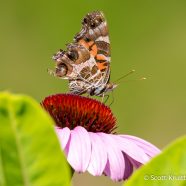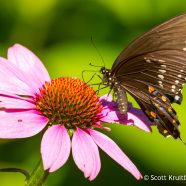American Goldfinch Eating Coneflowers
Finally! It took me a while, but here is photographic proof of why you should not cut any dead coneflower heads. This American Goldfinch was chowing down and enjoying it so much that it ignored me. I frequently hear and occasionally see them dining like this, but never when my camera is near or I am close to them. Many plants end up producing delicious seeds in their…less aesthetically pleasing stages…and should be left alone as a meal for many forms of wildlife, or even just to propagate their species. Scott Kruitbosch Conservation & Outreach Coordinator
Read MoreConeflower Seeds
Here is where I would be posting a photo of a gorgeous American Goldfinch feeding on the seed heads of mature Eastern Purple Coneflowers, but sadly whenever I am outdoors I either flush the birds unintentionally first, or I get to watch them without a camera in my hand. Fingers crossed for the future…but you should leave your coneflowers be and resist pruning them even when they are wilting and getting “ugly” so that the birds can enjoy a seed feast in the late summer and fall. Scott Kruitbosch Conservation & Outreach Coordinator
Read MoreTattered Lady
The American Painted Lady (Vanessa virginiensis) is best identified when nectaring like this by the two large eyespots on the ventral hindwing. The very similar Painted Lady (Vanessa cardui) would have four smaller eyespots in the same place. This individual is tattered and torn, experiencing some wear and tear after being busy on the wing for probably only a couple weeks, or a few at most. Adult life spans are short for many of our butterflies, and they have a lot to get done in such a small window, which makes it all the more important to have plentiful, widespread and organic food...
Read MoreSpicebush Swallowtail on Eastern Purple Coneflower
This breathtaking sight was a recent morning surprise for me as once again the wonderful Eastern Purple Coneflower (Echinacea purpurea) brought in a special friend in the form of a Spicebush Swallowtail (Papilio troilus) butterfly. It can be somewhat difficult to identify the Spicebush Swallowtail as the Black Swallowtail (Papilio polyxenes) looks very similar. To me, in terms of general and unscientific impressions, the Spicebush Swallowtail is a duller black, flies a little stronger, and seems a little larger with broad wings. One scientific way to tell the species apart if you have a view...
Read MoreSilver-spotted Skipper
Here are a couple more photos of that Silver-spotted Skipper (Epargyreus clarus) enjoying some Eastern Purple Coneflower (Echinacea purpurea) from last week. If only we could see what those eyes must see…
Read More








